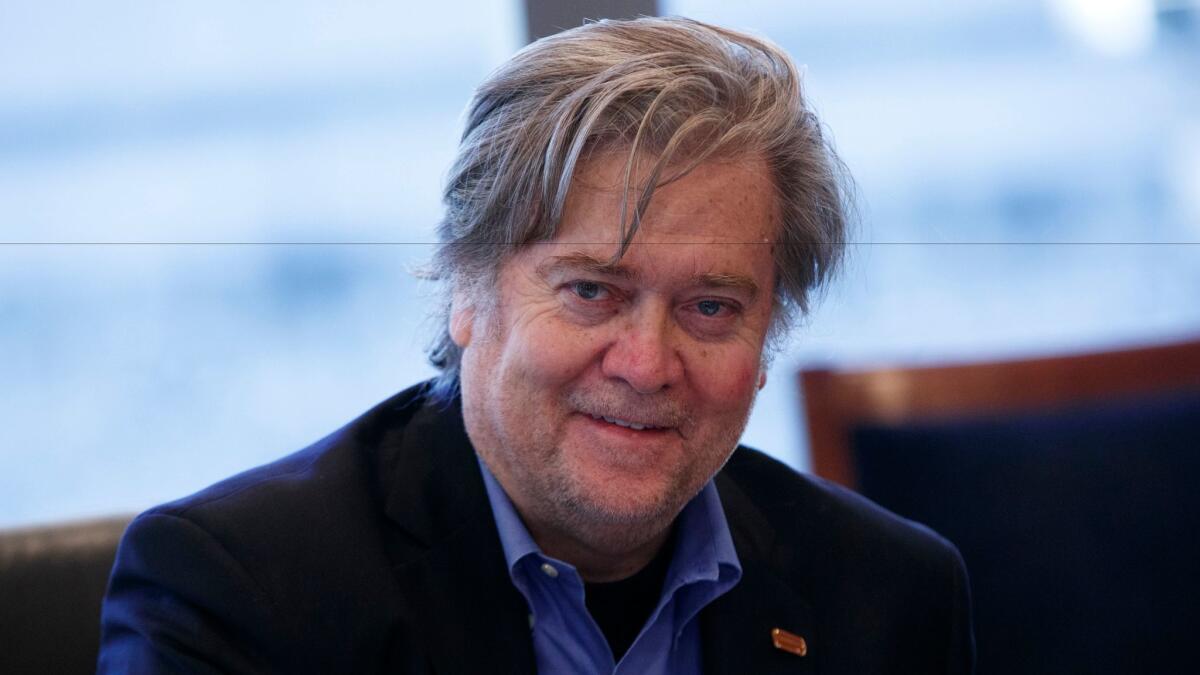Trump removes Stephen Bannon from National Security Council in staff shake-up

- Share via
Reporting from Washington — President Trump removed his controversial chief strategist, Stephen K. Bannon, from the powerful National Security Council in a high-level staff reshuffle that consolidated the power of White House national security advisor H.R. McMaster.
During the first weeks of his presidency, Trump was sharply criticized for authorizing Bannon to attend all NSC meetings, a move that gave the outspoken political advisor outsized influence over military and intelligence decisions from the policy-making body.
The reorganization, which also affected several other key aides, largely brings a traditional structure back to a White House national security system that has been roiled by leaks, infighting and intrigue since Trump took office.
As a result, Bannon, a divisive figure in the Trump orbit, will focus more on domestic policy while Jared Kushner, Trump’s son-in-law, will help conduct foreign affairs, and a trio of generals — McMaster, Defense Secretary James N. Mattis and Homeland Security Secretary John F. Kelly — will take the lead on national security.
The revamp reduced the role of Trump’s Homeland Security advisor, Tom Bossert, and restored Dan Coats, director of national intelligence, and Joseph Dunford, chairman of the Joint Chiefs of Staff, as regular attendees at NSC meetings. Their initial removal had rankled national security veterans.
The high-level reshuffle comes during a crucial week for Trump’s national security team. Trump met the president of Egypt on Monday, the king of Jordan on Wednesday and will meet the president of China on Thursday and Friday — and faced escalating crises in Syria and North Korea.
Though Trump is hardly the first president to shift key advisors early in his administration, the backbiting in his White House has been especially intense, with every move viewed through the prism of a zero-sum contest between top advisors jockeying for influence with a president who has a reputation for stoking such competition.
Such was the case last week when Katie Walsh, the top deputy to White House Chief of Staff Reince Priebus, left her post after the administration’s efforts to repeal and replace Obamacare suffered an early and perhaps fatal setback in the Republican-led Congress. All sides said publicly it was a mutual decision.
On Wednesday, White House officials similarly cast the ouster of Bannon from the NSC as insignificant. They said he had not attended many council meetings since he was given a regular seat on Jan. 28, shortly after Trump took office.
“There was no shake-up,” a White House official said, speaking on the condition of anonymity to discuss internal deliberations.
Bannon believed President Obama’s national security aides got too involved in day-to-day operations of the U.S. security apparatus and he wanted to “de-operationalize” the NSC to make it more of an advisory body in the White House, the official said.
The changes were disclosed in a notice published Wednesday in the Federal Register.
Trump named McMaster, an Army lieutenant general, as his national security advisor in late February after his first choice, Michael Flynn, was forced to resign for misleading Vice President Mike Pence about his phone calls with the Russian ambassador.
The White House said at the time that McMaster would have full authority to choose personnel on the council. He has methodically done so over the last six weeks.
James Carafano, a foreign policy analyst for the Heritage Foundation, a conservative think tank, said the changes at the NSC were a “natural evolution” for a young administration, particularly after McMaster took over for Flynn.
“You can think you know how a White House should run. And you may have been in a White House before. But the reality is, it has to work for that particular president,” he said. “It’s almost impossible with 100% clarity to know exactly what that should look like on Day One.”
Bannon, the former head of the far-right website Breitbart News, can still attend the high-level meetings when he is invited.
As chief strategist, Bannon has pushed Trump toward a more isolationist policy that holds an especially dark view of the Muslim world. His large portfolio and nationalistic views, as well as his pugnacious style, have made him a target for White House critics.
He has advocated for upending long-standing diplomatic and military alliances with allies, and was closely involved in Trump’s failed attempts to ban travelers from six Muslim-majority countries from entering the U.S., orders that have been repeatedly blocked in federal courts.
His removal from the NSC may reflect Bannon’s decision to pick his battles in the West Wing.
Early in the administration, Bannon was at Trump’s side for nearly every meeting, serving as the unofficial conscience of the Trump voter, pushing for the travel ban and increased deportations, said a White House official who has been in dozens of Oval Office meetings.
But in recent weeks, Bannon has been less ubiquitous, the official said.
In the last month, Kushner has gained increasing influence with Trump on setting Middle East policy and improving relations with China, arguably America’s most important bilateral relationship.
Partly as a result, Bannon has stepped back from areas where Kushner has Trump’s ear. He instead has focused on restructuring trade deals, rolling back government regulations, jousting with Congress on replacing the Affordable Care Act and protecting Trump’s restrictive policies on immigration.
“People have to be realistic about the role that Jared and Bannon are going to play,” said Carafano, who advised the Trump campaign and then the transition team on foreign policy and domestic security issues. “They’ve got these outsized portfolios but virtually no staff.… What people are finding is, you craft your portfolios, and then as you get in you realize maybe that’s not exactly how things are going to work, or should work.”
Carafano said the revised NSC structure reflected its original goal as a body that coordinates the actions of officials in the West Wing and the president’s Cabinet.
“The changes in the White House seem to reflect an honest effort to make sure that everybody feels like they’re working as a team,” he said.
Democrats saw the shift as reflective of controversies that have dogged the new administration, particularly the fallout from Flynn’s resignation and the president’s unproven claims that Obama wiretapped him during the campaign.
Rep. Elijah E. Cummings (D-Md.), the top Democrat on the House Oversight Committee, questioned whether Bannon was involved with dealings between NSC staff and Rep. Devin Nunes (R-Tulare), chairman of the House Intelligence Committee that is investigating Russian interference in the U.S. election.
Rep. Adam B. Schiff (D-Burbank), the top Democrat on the House Intelligence Committee, called Bannon’s removal from the NSC “a positive step” by McMaster “to gain control over a body that was being politicized by Bannon’s involvement.”
“As the administration’s policy over North Korea, China, Russia and Syria continues to drift, we can only hope this shake-up brings some level of strategic vision to the body,” Schiff said.
Twitter: @ByBrianBennett
ALSO
Mike Pence won’t dine alone with a woman who’s not his wife. Is that sexist?
At Trump’s EPA, going to work can be an act of defiance
More to Read
Get the L.A. Times Politics newsletter
Deeply reported insights into legislation, politics and policy from Sacramento, Washington and beyond. In your inbox twice per week.
You may occasionally receive promotional content from the Los Angeles Times.










